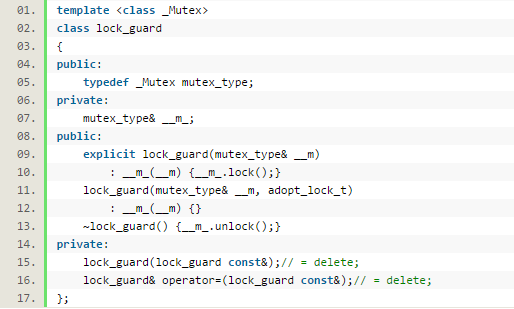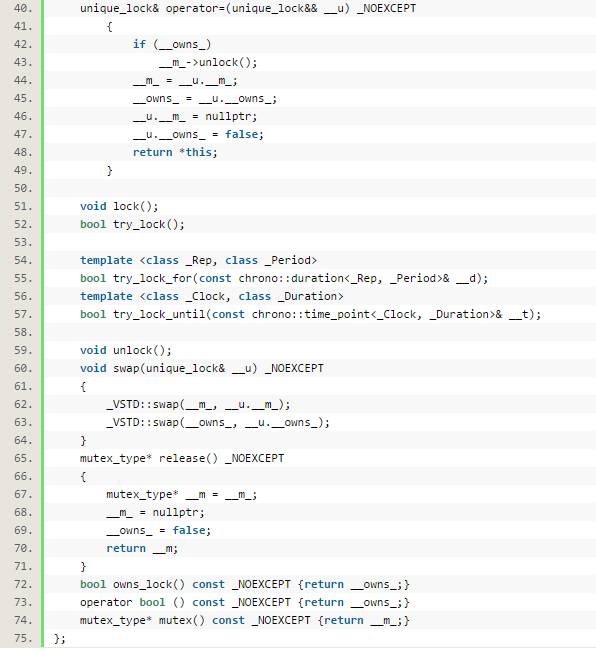(点击上方公众号,可快速关注)
来源:hengyunabc
链接:https://blog.csdn.net/hengyunabc/article/details/33336795
本文分析的是llvm libc++的实现:https://libcxx.llvm.org/
C++11中的各种mutex, lock对象,实际上都是对posix的mutex,condition的封装。不过里面也有很多细节值得学习。
std::mutex
先来看下std::mutex:
包增了一个pthread_mutex_t __m_,很简单,每个函数该干嘛就干嘛。

三种锁状态:std::defer_lock, std::try_to_lock, std::adopt_lock
这三个是用于标识锁在传递到一些包装类时,锁的状态:
std::defer_lock,还没有获取到锁
std::try_to_lock,在包装类构造时,尝试去获取锁
std::adopt_lock,调用者已经获得了锁
这三个东东,实际上是用于偏特化的,是三个空的struct:

在下面的代码里,就可以看到这三个东东是怎么用的了。
std::lock_guard
这个类比较重要,因为我们真正使用lock的时候,大部分都是要用这个。
这个类其实很简单:
在构造函数里调用 mutext.lock(),
在释构函数里,调用了mutex.unlock() 函数。
因为C++会在函数抛出异常时,自动调用作用域内的变量的析构函数,所以使用std::lock_guard可以在异常时自动释放锁,这就是为什么要避免直接使用mutex的函数,而是要用std::lock_guard的原因了。

注意,std::lock_guard的两个构造函数,当只传递mutex时,会在构造函数时调用mutext.lock()来获得锁。
当传递了adopt_lock_t时,说明调用者已经拿到了锁,所以不再尝试去获得锁。
std::unique_lock
unique_lock实际上也是一个包装类,起名为unique可能是和std::lock函数区分用的。
注意,多了一个owns_lock函数和release()函数,这两个在std::lock函数会用到。
owns_lock函数用于判断是否拥有锁;
release()函数则放弃了对锁的关联,当析构时,不会去unlock锁。
再看下unique_lock的实现,可以发现,上面的三种类型就是用来做偏特化用的:


std::lock 和 std::try_lock 函数
上面的都是类对象,这两个是函数。
std::lock和std::try_lock函数用于在同时使用多个锁时,防止死锁。这个实际上很重要的,因为手写代码来处理多个锁的同步问题,很容易出错。
要注意的是std::try_lock函数的返回值:
当成功时,返回-1;
当失败时,返回第几个锁没有获取成功,以0开始计数;
首先来看下只有两个锁的情况,代码虽然看起来比较简单,但里面却有大文章:
template<class_L0, class_L1>
void lock(_L0& __l0,_L1& __l1)
{
while(true)
{
{
unique_lock __u0(__l0);
if(__l1.try_lock())//已获得锁l0,再尝试获取l1
{
__u0.release();//l0和l1都已获取到,因为unique_lock在释构时会释放l0,所以要调用release()函数,不让它释放l0锁。
break;
}
}//如果同时获取l0,l1失败,这里会释放l0。
sched_yield();//把线程放到同一优先级的调度队列的尾部,CPU切换到其它线程执行
{
unique_lock __u1(__l1);//因为上面尝试先获取l1失败,说明有别的线程在持有l1,那么这次先尝试获取锁l1(只有前面的线程释放了,才可能获取到)
if(__l0.try_lock())
{
__u1.release();
break;
}
}
sched_yield();
}
}
template<class_L0, class_L1>
int try_lock(_L0& __l0,_L1& __l1)
{
unique_lock __u0(__l0,try_to_lock);
if(__u0.owns_lock())
{
if(__l1.try_lock())//注意try_lock返回值的定义,否则这里无法理解
{
__u0.release();
return-1;
}
else
return1;
}
return0;
}
上面的lock函数用尝试的办法防止了死锁。
上面是两个锁的情况,那么在多个参数的情况下呢?
先来看下std::try_lock函数的实现:
里面递归地调用了try_lock函数自身,如果全部锁都获取成功,则依次把所有的unique_lock都release掉。
如果有失败,则计数失败的次数,最终返回。
template<class_L0, class_L1, class_L2, class... _L3>
int try_lock(_L0& __l0,_L1& __l1,_L2& __l2,_L3&...__l3)
{
int__r= 0;
unique_lock __u0(__l0,try_to_lock);
if(__u0.owns_lock())
{
__r= try_lock(__l1,__l2,__l3...);
if(__r== -1)
__u0.release();
else
++__r;
}
return__r;
}
再来看多参数的std::lock的实现:
template<class_L0, class_L1, class_L2, class..._L3>
void __lock_first(int__i,_L0& __l0,_L1& __l1,_L2& __l2,_L3& ...__l3)
{
while(true)
{
switch(__i)//__i用来标记上一次获取参数里的第几个锁失败,从0开始计数
{
case0: //第一次执行时,__i是0
{
unique_lock __u0(__l0);
__i= try_lock(__l1,__l2,__l3...);
if(__i== -1)//获取到l0之后,如果尝试获取后面的锁也成功了,即全部锁都获取到了,则设置unique_lock为release,并返回
{
__u0.release();
return;
}
}
++__i;//因为__i表示是获取第几个锁失败,而上面的try_lock(__l1,__l2__l3,...)是从l1开始的,因此这里要+1,调整到没有获取成功的锁上,下次先从它开始获取。
sched_yield();
break;
case1: //说明上次获取l1失败,这次先获取到l1。
{
unique_lock __u1(__l1);
__i= try_lock(__l2,__l3...,__l0);//把前一次的l0放到最后。这次先获取到了l1,再尝试获取后面的锁。
if(__i== -1)
{
__u1.release();
return;
}
}
if(__i== sizeof...(_L3)+ 1)//说明把l0放到最后面时,最后获取l0时失败了。那么说明现在有其它线程持有l0,那么下一次要从l0开始获取。
__i= 0;
else
__i+= 2;//因为__i表示是获取第几个锁失败,而上面的try_lock(__l2,__l3..., __l0)是从l2开始的,因此这里要+2
sched_yield();
break;
default:
__lock_first(__i- 2,__l2,__l3...,__l0,__l1);//因为这里是从l2开始的,因此__i要减2。
return;
}
}
}
template<class_L0, class_L1, class_L2, class..._L3>
inline_LIBCPP_INLINE_VISIBILITY
void lock(_L0& __l0,_L1& __l1,_L2& __l2,_L3& ...__l3)
{
__lock_first(0,__l0,__l1,__l2,__l3...);
}
可以看到多参数的std::lock的实现是:
先获取一个锁,然后再调用std::try_lock去获取剩下的锁,如果失败了,则下次先获取上次失败的锁。
重复上面的过程,直到成功获取到所有的锁。
上面的算法用比较巧妙的方式实现了参数的轮转。
std::timed_mutex
std::timed_mutex 是里面封装了mutex和condition,这样就两个函数可以用:
try_lock_for
try_lock_until
实际上是posix的mutex和condition的包装。
classtimed_mutex
{
mutex __m_;
condition_variable __cv_;
bool__locked_;
public:
timed_mutex();
~timed_mutex();
private:
timed_mutex(consttimed_mutex&);// = delete;
timed_mutex& operator=(consttimed_mutex&);// = delete;
public:
voidlock();
booltry_lock()_NOEXCEPT;
template<class_Rep, class_Period>
_LIBCPP_INLINE_VISIBILITY
booltry_lock_for(constchrono::duration& __d)
{returntry_lock_until(chrono::steady_clock::now()+ __d);}
template<class_Clock, class_Duration>
booltry_lock_until(constchrono::time_point& __t);
voidunlock()_NOEXCEPT;
};
template<class_Clock, class_Duration>
bool timed_mutex::try_lock_until(constchrono::time_point& __t)
{
usingnamespacechrono;
unique_lock __lk(__m_);
boolno_timeout= _Clock::now();
}
std::recursive_mutex和std::recursive_timed_mutex
这两个实际上是std::mutex和std::timed_mutex 的recursive模式的实现,即锁得获得者可以重复多次调用lock()函数。
和posix mutex里的recursive mutex是一样的。
看下std::recursive_mutex的构造函数就知道了。
recursive_mutex::recursive_mutex()
{
pthread_mutexattr_t attr;
intec= pthread_mutexattr_init(&attr);
if(ec)
gotofail;
ec= pthread_mutexattr_settype(&attr,PTHREAD_MUTEX_RECURSIVE);
if(ec)
{
pthread_mutexattr_destroy(&attr);
gotofail;
}
ec= pthread_mutex_init(&__m_,&attr);
if(ec)
{
pthread_mutexattr_destroy(&attr);
gotofail;
}
ec= pthread_mutexattr_destroy(&attr);
if(ec)
{
pthread_mutex_destroy(&__m_);
gotofail;
}
return;
fail:
__throw_system_error(ec,"recursive_mutex constructor failed");
}
std::cv_status
这个用来表示condition等待返回的状态的,和上面的三个表示lock的状态的用途差不多。
enumcv_status
{
no_timeout,
timeout
};
std::condition_variable
包装了posix condition variable。
classcondition_variable
{
pthread_cond_t __cv_;
public:
condition_variable(){__cv_= (pthread_cond_t)PTHREAD_COND_INITIALIZER;}
~condition_variable();
private:
condition_variable(constcondition_variable&);// = delete;
condition_variable& operator=(constcondition_variable&);// = delete;
public:
voidnotify_one()_NOEXCEPT;
voidnotify_all()_NOEXCEPT;
voidwait(unique_lock& __lk)_NOEXCEPT;
template<class_Predicate>
voidwait(unique_lock& __lk,_Predicate __pred);
template<class_Clock, class_Duration>
cv_status wait_until(unique_lock& __lk,
constchrono::time_point& __t);
template<class_Clock, class_Duration, class_Predicate>
boolwait_until(unique_lock& __lk,
constchrono::time_point& __t,
_Predicate __pred);
template<class_Rep, class_Period>
cv_statuswait_for(unique_lock& __lk,
constchrono::duration& __d);
template<class_Rep, class_Period, class_Predicate>
bool wait_for(unique_lock& __lk,
constchrono::duration& __d,
_Predicate __pred);
typedefpthread_cond_t* native_handle_type;
_LIBCPP_INLINE_VISIBILITY native_handle_type native_handle(){return&__cv_;}
private:
void__do_timed_wait(unique_lock& __lk,
chrono::time_point)_NOEXCEPT;
};
里面的函数都是符合直觉的实现,值得注意的是:
cv_status是通过判断时间而确定的,如果超时的则返回cv_status::timeout,如果没有超时,则返回cv_status::no_timeout。
condition_variable::wait_until函数可以传入一个predicate,即一个用户自定义的判断是否符合条件的函数。这个也是很常见的模板编程的方法了。
template<class_Clock, class_Duration>
cv_status condition_variable::wait_until(unique_lock& __lk,
constchrono::time_point& __t)
{
usingnamespacechrono;
wait_for(__lk,__t- _Clock::now());
return_Clock::now()
bool condition_variable::wait_until(unique_lock& __lk,
constchrono::time_point& __t,
_Predicate __pred)
{
while(!__pred())
{
if(wait_until(__lk,__t)== cv_status::timeout)
return__pred();
}
returntrue;
}
std::condition_variable_any
std::condition_variable_any的接口和std::condition_variable一样,不同的是std::condition_variable只能使用std::unique_lock,而std::condition_variable_any可以使用任何的锁对象。
下面来看下为什么std::condition_variable_any可以使用任意的锁对象。
class_LIBCPP_TYPE_VIScondition_variable_any
{
condition_variable __cv_;
shared_ptr __mut_;
public:
condition_variable_any();
voidnotify_one()_NOEXCEPT;
voidnotify_all()_NOEXCEPT;
template<class_Lock>
voidwait(_Lock& __lock);
template<class_Lock, class_Predicate>
voidwait(_Lock& __lock,_Predicate __pred);
template<class_Lock, class_Clock, class_Duration>
cv_status wait_until(_Lock& __lock,
constchrono::time_point& __t);
template<class_Lock, class_Clock, class_Duration, class_Predicate>
bool wait_until(_Lock& __lock,
constchrono::time_point& __t,
_Predicate __pred);
template<class_Lock, class_Rep, class_Period>
cv_status wait_for(_Lock& __lock,
constchrono::duration& __d);
template<class_Lock, class_Rep, class_Period, class_Predicate>
bool wait_for(_Lock& __lock,
constchrono::duration& __d,
_Predicate __pred);
};
可以看到,在std::condition_variable_any里,用shared_ptr __mut_来包装了mutex。所以一切都明白了,回顾std::unique_lock,它包装了mutex,当析构时自动释放mutex。在std::condition_variable_any里,这份工作让shared_ptr来做了。
因此,也可以很轻松得出std::condition_variable_any会比std::condition_variable稍慢的结论了。
其它的东东:
sched_yield()函数的man手册:
sched_yield() causes the calling thread to relinquish the CPU. The thread is moved to the end of the queue for its
static priority and a new thread gets to run.
在C++14里还有std::shared_lock和std::shared_timed_mutex,但是libc++里还没有对应的实现,因此不做分析。
总结
llvm libc++中的各种mutex, lock, condition variable实际上是封闭了posix里的对应实现。封装的技巧和一些细节值得细细推敲学习。
看完了实现源码之后,对于如何使用就更加清晰了。
参考:
https://en.cppreference.com/w/cpp
https://libcxx.llvm.org/
关注「CPP开发者」
看更多精选C/C++技术文章
↓↓↓

 )
)





























我来说两句排行榜